Features of growing ginger at home
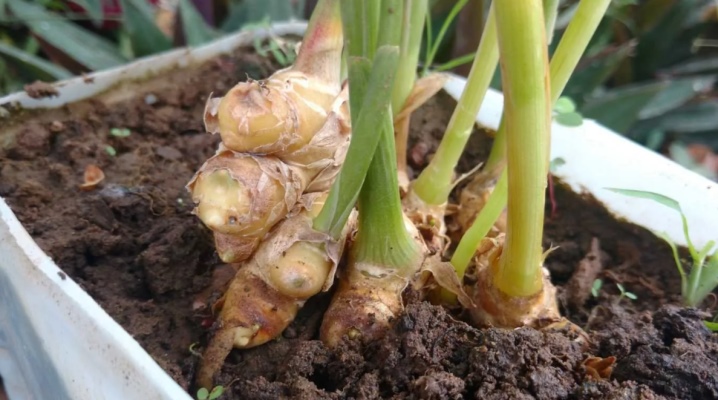
Growing ginger at home is not that difficult. The main thing is to choose the right planting material, and in the future to provide the culture with proper care.
Variety selection
For growing at home, only some varieties of the crop are recommended. For example, you can plant "Black" or "Barbados" ginger in a pot. Its tubers have a pungent taste, and the smell is bright. Before using such a product, you do not even have to peel off the peel - it turns out to be sufficient to sprinkle a piece with hot water and dry it. Popular is also "White", aka "Bengal" ginger. This variety is characterized by a mild taste and unobtrusive aroma. Before use, the pulp must be peeled off. The above two varieties are also the most prolific.
If the culture is planned to be grown exclusively for decorative purposes, then it is worth paying attention to such varieties as "Purple", "Japanese" and "Wonderful". "Purple" throws out a peduncle with a bright red bud, "Wonderful" pleases with scarlet inflorescences that do not fade for a long time, and "Japanese" is considered the most fragrant. The flowers of "Zerumbet" look like roses, and the snow-white buds of "Kassumunar" are reminiscent of orchids.
It is worth mentioning that some varieties of ginger, famous for their beautiful flowering, generally do not show medicinal properties, and therefore this point should be clarified in advance.
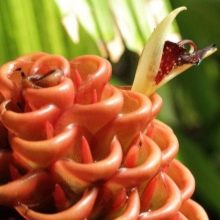
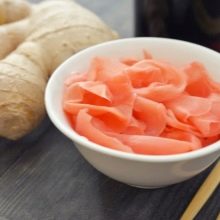

Timing
For the cultivation of ginger to be successful, it is planted at the end of February or in the first weeks of March. In winter, the procedure is not carried out, as the culture may not have enough natural light. If a suitable root vegetable was purchased in winter, it is recommended to pack it in a bag and store it in the vegetable compartment of the refrigerator compartment. Such conditions will allow the culture to gradually awaken. Then, by the beginning of March, it will be ready for planting.

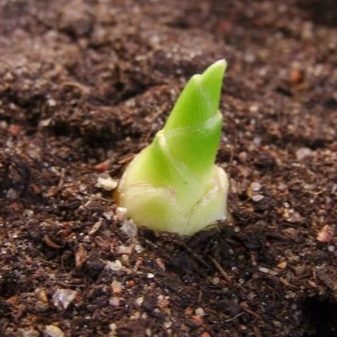
Preparing for landing
An important step in preparing for planting ginger is choosing the right material. Reproduction of the culture can be carried out by the seed method, but the division of the roots is considered an easier way. It is the second method that is best used to grow ginger in the country or at home on the windowsill. The spine purchased from the store should be smooth, without any roughness or wrinkles. In addition, it is important that on its surface there are points similar to the eyes of a potato. The more there are, the better.
It is necessary that inside the root tuber there is an elastic, juicy pulp, practically free of fibers. When pressed, the root should not deform, remaining rigid. The selected material must be examined for diseases - dark spots or dents. The color will also have to be assessed: a rich brown color indicates that the tuber has been stored for a long time in improper conditions. Preference should be given to rhizomes with a light shell and delicate structure.
Before starting germination, the root will need to be disinfected. It will be very easy to dilute a weak solution of potassium permanganate and soak the material in it for 12 hours. In order for the ginger to sprout quickly, you will also need to awaken its buds. This is done in several ways.The first one involves keeping the seedlings in boiled water, heated to + 60 ... 70 degrees, for 2-4 hours.

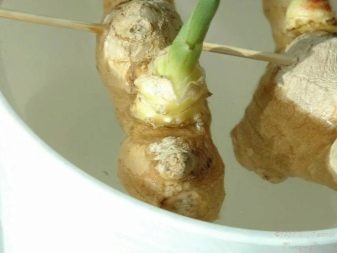
You can also germinate a root crop if you place it buds up in a container between layers of sphagnum moss. The entire contents of the container are well moistened, after which it is transferred to a well-lit and heated place. Finally, ginger will germinate faster if it stays impaled on thin wooden skewers for some time, which, in turn, are fixed over a vessel filled with liquid. The lower part of the rhizomes thereby sinks a few millimeters into the water. A large, treated tuber is ideally cut into small pieces, each of which retains a pair of growth points. Fragments should be separated by connecting thickenings, a kind of jumpers. The exposed wounds are sprinkled with wood ash or crushed activated carbon.
It is equally important to prepare the soil mixture. The optimal soil for a crop is a combination of 1 part clay and 3 parts peat. In principle, it is not forbidden to use the land left after planting vegetables, although it is much more optimal to purchase a ready-made soil substrate for citrus fruits. A mixture of garden soil, river sand and leaf humus, taken in equal proportions, is also suitable.
The choice of capacity is carried out depending on the purpose for which it is planned to grow ginger: decorative or medicinal.
In the second case, you will need a low medium-sized container with wide sides, and in the first case, you can choose any decorative, moderately free planter. The pot must have holes for draining water, as well as a drainage layer of sand or broken expanded clay. On top of the drainage, the layer of which is from 3 to 5 centimeters, soil is poured, or sphagnum moss is located. After filling, the container should remain free by a third.
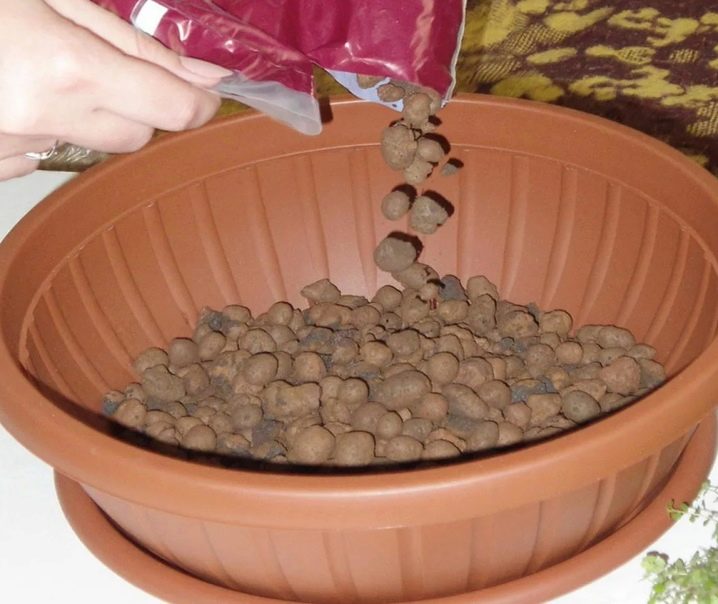
How to plant correctly?
Planting ginger is easy. It should not be deepened much, it is enough that no more than 1-2 centimeters hide in the ground. In this case, the kidneys should remain on top, as close to the surface as possible. It is recommended to lay out the spine not in the center of the container, but on the side - so that the cut just looks at the wall of the pot. This procedure is carried out only after the ginger sprouts the first green shoots.
The plantings are abundantly irrigated with water at room temperature, after which the container is tightened with a film and removed to a well-lit and heated place. It is allowed to remove the covering material no earlier than a month after the sprouts of the plant hatch.
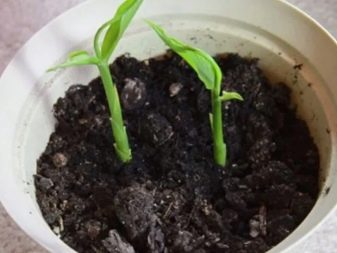
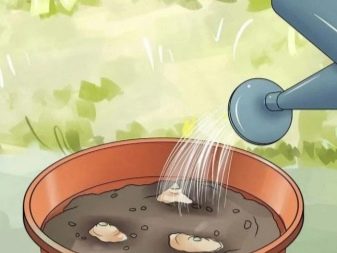
The nuances of care
To successfully grow ginger from the root of the house on the windowsill, and in the garden, it is necessary to create the proper conditions for the plant. So, in the spring months, the culture requires a temperature of +15 to +20 degrees, and in the summer - about + 27 ... 32 degrees. We must not forget that ginger reacts poorly to temperature jumps, therefore, the regime should not be drastically changed. The culture, being tropical, grows well only with an abundance of sunlight, but it cannot be under the scorching rays - exposure to the midday sun can even lead to burns. At home, it is more correct to place ginger on the western or eastern windows, and on open ground - with the possibility of shading.
When the heating season comes, special attention will have to be paid to maintaining high humidity. If possible, the plant is removed from heating devices, but if this is not possible, then it will need to be sprayed 2-3 times a day.
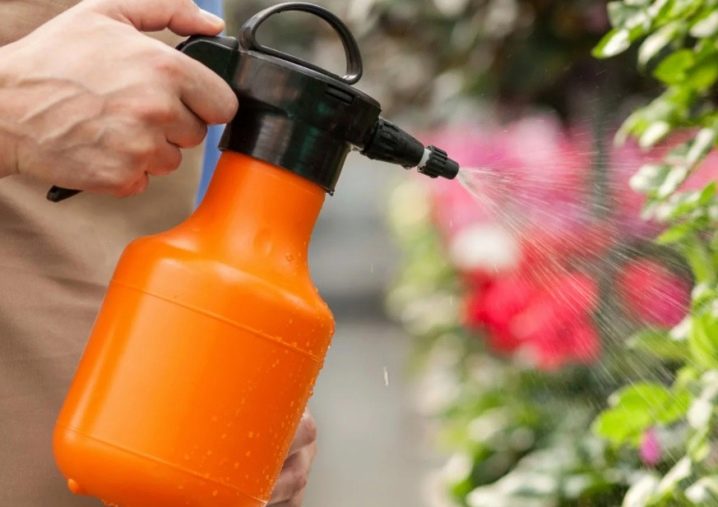
Watering
It is impossible to care for ginger without regular irrigation - about once every 4 days. The land must be kept moist, but not flooded. Excess moisture after each watering will have to be drained from the pallet. If the plant looks wilted, and its leaves are crumbling, then this may indicate a lack of irrigation. A soft, settled liquid, warmed up to room temperature, should be used for the procedure. In winter, watering is reduced to once a week.
Top dressing
It is recommended to feed ginger by following the instructions step by step. It is allowed to introduce nutrients into the soil once every 12 days, and the procedures are necessarily carried out after the appearance of the first shoots and before direct flowering. The culture is suitable for balanced mineral complexes, as well as diluted solutions of mullein or bird droppings. From the beginning of August until the end of November, ginger is fed with potassium-containing fertilizers.
If a variety of ginger blooms beautifully, then it will definitely need phosphorus.
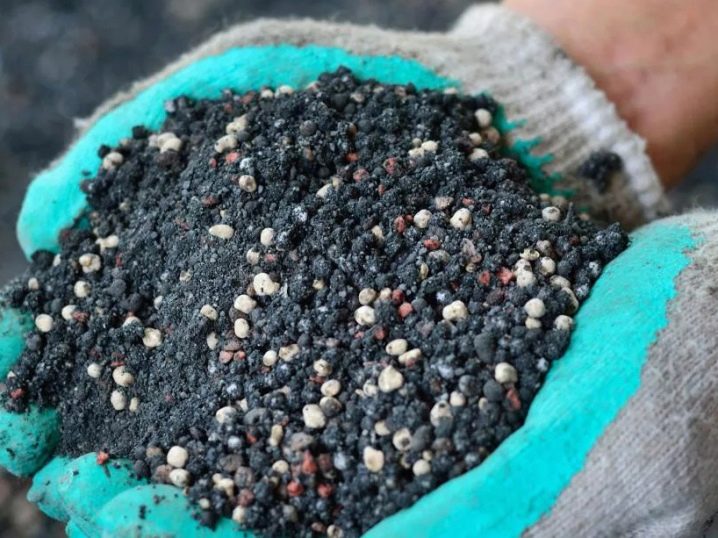
Diseases and pests
Ginger has good immunity, and therefore rarely gets infected or suffers from insect attacks. However, if the leaf blades are covered with a sticky bloom or dry out, then this indicates the vital activity of a spider mite, scale insects or aphids. To combat them, you will need to spray the plant with a 70% solution of laundry soap. The procedure will need to be carried out 2 times with a three-day interval. It will be possible to get rid of spider mites by treatment with chemical insecticides, as well as through regular watering and spraying.
In this case, the roots are protected with a film or a bag, and the above-ground part is washed with hot water heated to +40 degrees. After the procedure, the crown is tightened with cling film to create a moist warm environment incompatible with the life of insects.
If the plant has been over-watered, then it will need to be moved to new soil. If the leaves and stems of ginger turn yellow, it is recommended to normalize the process of humidifying the air and soil. Brown spots on the leaf blades are evidence of sunburn. In this case, it needs to be shaded.
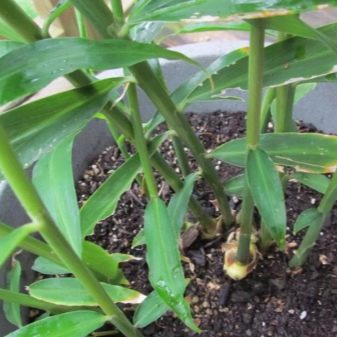
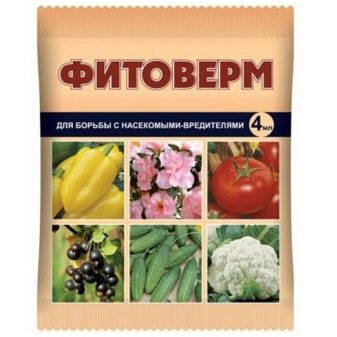
Helpful hints
If the stems of ginger begin to fall apart, and yellowed leaves fall from them, perhaps the problem is that it is time to harvest the crop - that is, to dig out the overgrown rhizomes. It is allowed to remove root crops only manually, since any garden equipment can harm the underground stem.
It is also worth mentioning the cultivation of ginger outdoors. In this case, the germination of roots is carried out at home or in a greenhouse, and in May the culture is already transferred to open ground. Outdoor ginger responds well to drip irrigation. It is required to regularly weed and cleaned of weeds, as well as water and feed. In September, roots are dug up and transplanted into a greenhouse. It is also possible to leave them in the ground until October, then put them in a cellar for the winter, and then transplant them back to an unprotected bed.
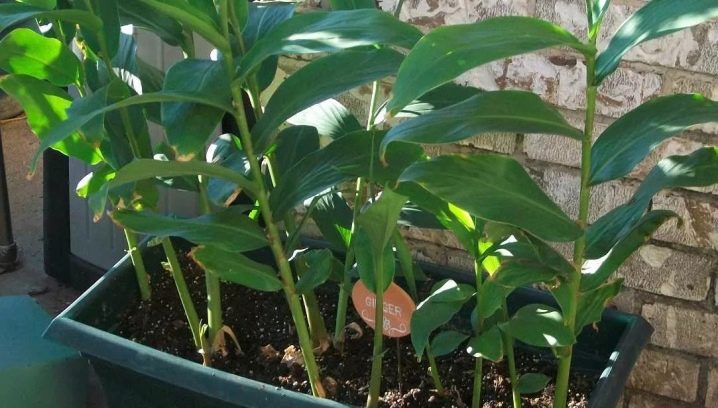































The comment was sent successfully.